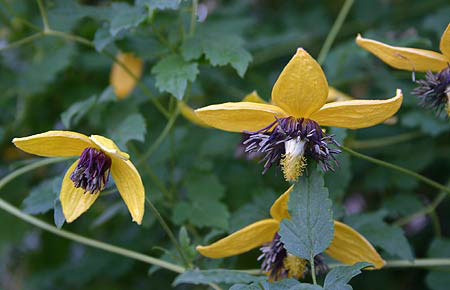Clematis 'Helios'
Family: Ranunculaceae
Pronounced: KLEM-uh-tiss
Quick Jumps
Growing Guide
Rainy Side Notes
GROWING GUIDE

Origin:
Garden.
Plant Group:
Vines.
Hardiness:
Sunset zones: A1, A3, 1-9, 14-17, 19-23.
USDA zones: 5-11.
Heat zones: 9-6.
Mature size:
Height: 6 feet (2 m).
Flowering period:
Late spring to early autumn.
Flowering attributes:
Single, partly nodding flowers with four yellow tepals and dark purple stamens, followed by attractive, silky seed heads.
Leaf attributes:
Bright green, deciduous leaves.
Light:
Partial shade to full sun.
Soil:
Fertile, humus rich soil with sharp drainage.
Feeding:
Mulch well with composted manure or compost. Feed once a month with a complete organic fertilizer during the growing season.
Propagation Methods:
Layer branches in late winter.
Basal and softwood cuttings in spring.
Division in spring.
Semi-ripe cuttings in early summer.
Pruning Methods:
Pruning group 3 or C.
Rainy Side Notes
In small gardens, the vines of the Clematis tangutica group outgrow their allotted space. For gardeners who wished for the sunny yellow blossoms of this group, yet did not have the space for the monster vines, along came the petite Clematis tangutica 'Helios' and solved the problem. C. 'Helios' was introduced in 1988 by the Boskoop Research Station in the Netherlands. A possible cross between Clematis tangutica and C. 'Golden Harvest', the vine grows 6-8 feet tall and flowers in waves over the summer. Later in the season the large, silky seed heads combine beautifully with the flowers, making C. 'Helios' a choice clematis for both the large and small garden. Reportedly attractive to hummingbirds, the vine offers up resistance to deer and bunnies, a plus for gardens with too many of either creature.
Raymond Evison, a breeder of many fine clematis cultivars, recommends growing C. 'Helios' on large rhododendrons, a shrub that is plentiful in our Pacific Northwest gardens. I agree; such scaffolding would be the perfect backdrop to the vine's cheerful yellow flowers and give a boost of color to the perpetually boring, evergreen shrubs. The flowers of the rhododendron will complete their cycle before the vine begins its floral show, so any flower color on the shrub would work. The exception would be late flowering rhododendrons; in that case, a deep purple blossom would contrast handsomely with the bright yellow clematis flowers.
Linda Beutler, author of Gardening with Clematis, recommends this vine in her top ten list for beginners. This is a great choice to wet the clematis appetite without discouragement, failure is more likely to come from growing a fussy one which is more suitable for a seasoned gardener.
This vine is hardy enough (in the maritime Pacific Northwest) to be suitable for containers, making it a choice vine for a deck or balcony where horizontal space is at a premium and vertical space is plenty.
Although considered in Clematis group 3 or C, the group that is recommended to prune hard in late winter, Helios will flower early if only half the vine is hard pruned at the same recommended time. Early flowers will appear on the old wood and later flowers will appear on the newer growth.
Planting and Care of Clematis.
Photographed in Tony Guisa and Jerry Fortner's Oregon garden.

Gardening for the Homebrewer: Grow and Process Plants for Making Beer, Wine, Gruit, Cider, Perry, and More
By co-authors Debbie Teashon (Rainy Side Gardeners) and Wendy Tweton
Copyright Notice | Home | Search | Vines

